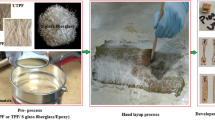Abstract
This study presents the tensile properties and cost-property efficiency analyses of a novel composite material type composed of expanded polystyrene as filler, chopped glass fibers as reinforcement agent and epoxy resin as matrix material. Composite specimens were fabricated via expanded polystyrene beads with two different densities, two different length of chopped glass fibers and three levels of fiber/filler weight ratios. Specimens were subjected to tensile tests and cost property analyses were carried out. Experimental studies revealed that novel composite specimens had significantly low density and high specific modulus. Cost-property efficiency analyses revealed that the novel composite is relatively highly efficient material and could be utilized instead of its more expensive counterparts such as conventional plastics or laminated composites especially for non-load bearing applications.
Similar content being viewed by others
Abbreviations
- CGF :
-
Chopped glass fiber
- EPS :
-
Expanded polystyrene
- GFRP :
-
Glass fiber reinforced plastic
- GPA :
-
Giga pascal
- HDPE:
-
High density polyethylene
- MPa:
-
Mega pascal
- PVC :
-
Polyvinyl chloride
- V:
-
Volume fraction
- w:
-
Weight
- ρ:
-
Density
References
M. F. Ashby, Materials Selection in Mechanical Design, Elsevier (2005).
A. K. Kaw, Mechanics of Composite Materials, Taylor & Francis Group, LLC (2006).
K. A. de Oliveira, J. C. Barbosa, A. L. Christoforo, J. C. Molina, C. A. B. Oliveira, M. S. Bertolini, M. Gava and G. Ventorim, Sound absorption of recycled gypsum matrix composites with residual cellulosic pulp and expanded polystyrene, Bioresources, 14(2) (2019) 4806–4813.
A. Erklig, M. Alsaadi and M. Bulut, A comparative study on industrial waste fillers affecting mechanical properties of polymer-matrix composites, Mater. Res. Express, 3 (10) (2016).
A. A. Solomon and G. Hemalatha, Characteristics of expanded polystyrene (EPS) and its impact on mechanical and thermal performance of insulated concrete form (ICF) system, Structures, 23 (2020) 204–213.
N. H. R. Sulong, S. A. S. Mustapa and M. K. A. Rashid, Application of expanded polystyrene (EPS) in buildings and constructions: a review, J. Appl. Polym. Sci., 136 (20) (2019).
S. S. Vaisakh, A. A. P. Mohammed, M. Hassanzadeh, J. F. Tortorici, R. Metz and S. Ananthakumar, Effect of nanomodified SiO2/Al2O3 mixed-matrix micro-composite fillers on thermal, mechanical, and tribological properties of epoxy polymers, Polym. Advan. Technol., 27(7) (2016) 905–914.
Z. Z. Wang, Z. Y. Huang and T. Yang, Silica coated expanded polystyrene/cement composites with improved fire resistance, smoke suppression and mechanical strength, Mater. Chem. Phys., 240 (2020).
Technical Information Epoxy and Phenolic Resins Division Epoxy Resins, Hexion Specialty Chemicals (2006).
S. Yildizhan, M. Ozcanli and H. Serin, Characteristics of chopped glass reinforced composite materials: a brief review, 3rd International Mediterranean Science and Engineering Congress (IMSEC 2018), Adana, Turkey (2018) 1413–1417.
E. Ernault, E. Richaud and B. Fayolle, Origin of epoxies embrittlement during oxidative ageing, Polym. Test, 63 (2017) 448–454.
K. P. Unnikrishnan and E. T. Thachil, Toughening of epoxy resins, Des. Monomers Polym., 9(2) (2006) 129–152.
F. L. Jin, X. Li and S. J. Park, Synthesis and application of epoxy resins: a review, J. Ind. Eng. Chem., 29 (2015) 1–11.
N. Saba, M. Jawaid, O. Y. Alothman, M. T. Paridah and A. Hassan, Recent advances in epoxy resin, natural fiber-reinforced epoxy composites and their applications, J. Reinf. Plast. Comp., 35(6) (2016) 447–470.
ASTM D3039/D3039M-17, Standard Test Method for Tensile Properties of Polymer Matrix Composite Materials, ASTM International, West Conshohocken, PA (2017).
B. Liu, R. Villavicencio and C. G. Soares, Failure characteristics of strength-equivalent aluminum and steel plates in impact conditions, Analysis and Design of Marine Structures, Marstruct, 2013 (2013) 167–174.
Technical Data, Plastem (Pty) Ltd., Germiston, South Africa (2020).
Acknowledgments
This research article is a part of the doctorate study. The authors would like to thank to Çukurova R&D for fabrication studies and Koluman Otomotiv Endüstri A.Ş. for testing studies. This study was supported by Cukurova University Scientific Research Project Coordination (FBA-2020-12502).
Author information
Authors and Affiliations
Corresponding author
Additional information
Hasan Serin was born in Tarsus-Turkey in 1977. He graduated from the Department of Mechanical Engineering at Cukurova University in 1999. He pursued his M.Sc. and Ph.D. studies at Cukurova University and got his degrees in 2002 and 2008, respectively. In 2003, he worked as a visiting researcher in Graz-Austria. He assigned a lecturer of mechanical engineering in between 2008 and 2013 and worked as an Assistant Professor between 2013 and 2015. He has been working at the Automotive Engineering Department as an Associate Professor since 2015. His main research interests are composite materials, heat transfer and biodiesel fuels.
Şafak Yıldızhan born in 1991 and studied Automotive Engineering at the Cukurova University, Adana, Turkey from 2009 to 2014. He studied and received his M.Sc. degree from Institute of Natural and Applied Science of Cukurova University in 2017. Currently he is a senior Ph.D. student at the same university. His main research interest is composite materials.
Rights and permissions
About this article
Cite this article
Serin, H., Yıldızhan, Ş. Tensile properties and cost-property efficiency analyses of expanded polystyrene/chopped glass fiber/epoxy novel composite. J Mech Sci Technol 35, 145–151 (2021). https://doi.org/10.1007/s12206-020-1213-1
Received:
Revised:
Accepted:
Published:
Issue Date:
DOI: https://doi.org/10.1007/s12206-020-1213-1




